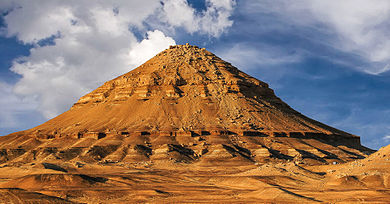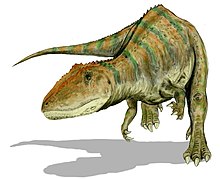Bahariya formation
The Bahariya Formation (also Baharija, Bahariyya or Bahriya Formation) is a siliciclastic layer structure that was deposited during the Cenomanian in northern Egypt . It was first scientifically described in 1914 by Ernst Stromer von Reichenbach under the designation "Baharije stage". She is best known for her vertebrate fossil guide.
The type locality of this formation is the Bahariyya Depression , which is deepened in a plateau of Eocene limestone . The Bahariya formation there forms the bottom and the lower part of the relatively steep slope that lines the depression, as well as the lower slopes of some of the larger elevations within the depression. The type profile is on Gebel El-Dist in the north of the valley. The Bahariya Formation is very widespread and stratigraphic equivalents similar to faciell can still be found on the Sinai Peninsula and in Israel .
Iron ore is mined in the northeastern part of the Bahariyya Depression (finds at Gebel Ghorabi, area around El-Harra and El-Gedida). Recently, the Bahariya Formation has also gained international interest as a storage rock for fossil hydrocarbons.
Geological background
The Bahariya Formation began to deposit approximately 97 million years ago and lasted for 3 to 6 million years. It coincided with the so-called cenomanian transgression , a sea level rise that can be detected worldwide, at the peak of which levels were reached that were locally up to 200 meters above today's level. The advance of the Tethys Sea took place in Egypt from north to south. Large parts of the partly tectonically troubled (with rift fractures in the Jura) passive continental margin of the Arab-Nubian craton were gradually flooded.
Stratigraphy and facies
The thickness of the Bahariya Formation in the tectonically stable part of the passive continental margin is 100 to 200 meters - in the type locality it is 90 to 100 meters. In the tectonically troubled shelf area further north, however, their thickness can grow to 400 to 500 meters.
The formation is usually divided into three layers (hanging wall on top):
- El Heiz Member - lagunar to supratidal sequence with dark ferruginous sandstones - retreat of the Cenoman Sea
- Gebel Dist Member - estuarine sequence with diagonally layered sandstones
- Gebel Ghorabi Member - fluvial sand and siltstones
However, some authors separate the El Heiz member from the Bahariya formation and regard it as a separate formation.
The base of the Bahariya Formation is nowhere exposed , but is likely to be discordant on the basement . The formation is superimposed discordantly by the El Hefhuf Formation of the Upper Cretaceous or directly by the Eocene limestones of the El Naqb Formation , which build up the plateau around the Bahryia Depression.
Overall, the facies in the Bahariya Formation indicate near-shore deposit conditions. The then western Neotethys is likely to have been a tropical, warm-temperate shelf sea in northern Egypt.
Fauna of the Bahariya Formation
The fossil content of the Bahariya Formation is quite diverse. In addition to a species-rich fish fauna, there are remains of crabs , primitive crocodiles , turtles , primitive snakes , dinosaurs and plesiosaurs . Vegetable remains of tree ferns (with the mangrove species Weichselia reticulata ) and bedecktsamern (Angiospermae) have also been preserved.
The Bahariya formation became known through Stromer's dinosaur finds . Unfortunately, they were destroyed in the Second World War. In 2001 Joshua Smith of the University of Pennsylvania published the first scientific description of the sauropod dinosaur Paralititan stromeri, discovered in 2000 during new excavations in the Bahariya Formation . The following list contains a selection of systematic animal groups and some of their representatives that have been discovered in the formation so far:
Cartilaginous fish (Chondrichthyes)
- a total of 22 taxa, including
- Onchopristis numidus - Sclerorhynchidae
- Carcharoides planidens - Mackerel Sharks (Lamnidae)
- Tribodus sp. - Hybodontiformes
Bony fish (Osteichthyes)
- Bawitius bertheli - a gigantic pike several meters long
- Pycnodus sp. - Pycnodontiformes
- Enchodus sp. - Lizardfish relatives (Aulopiformes)
- Mawsonia lybica - a coelacanthiformes (Coelacanthiformes)up to 3 meters in size
- Lungfish (Dipnoi)
Scale reptiles (Squamata)
- Simoliophis - a forerunner of modern snakes ; probably still possessed remains of the hind limbs
Crocodylomorpha
- Stomatosuchus - a forerunner of the modern crocodile with an unusually shaped skull
Sauropoda
Theropoda
- Bahariasaurus
- Carcharodontosaurus
- Deltadromeus
- Sigilmassasaurus (or Spinosaurus B)
- Spinosaurus
literature
- O. Catuneanu, MA Khalifa, HA Wanas: Sequence stratigraphy of the Lower Cenomanian Bahariya Formation, Bahariya Oasis, Western Desert, Egypt. In: Sedimentary Geology. Vol. 90, No. 1-4, 2006, pp. 121-137, doi : 10.1016 / j.sedgeo.2006.05.010 (alternative full text access : ResearchGate ).
- Jean-Claude Rage, François Escuillié: Le Cénomanien: étage des serpents bipèdes. In: Carnets de Géologie. Vol. 3, item no. 1, 2003 ( online ).
- Rushdi Said (Ed.): Geology of Egypt . Egyptian General Petroleum Corporation, Conoco Hurghada u. a. - Balkema in commission, Rotterdam et al. 1990, ISBN 90-6191-856-1 .
- Barbara Smith Grandstaff: Giant fishes from the Bahariya Formation, Bahariya Oasis, Western Desert, Egypt . PhD dissertation / thesis, University of Pennsylvania, Philadelphia PA 2006 ( abstract ).
- Christa Werner: The Elasmobranch fauna of the Gebel Dist Member of the Bahariya Formation (Obercenoman) of the Bahariya Oasis, Egypt. Pfeil, Munich 1989, ISBN 3-923871-45-7 ( Palaeo Ichthyologica , Vol. 5; also: Dissertation, TU Berlin, 1989).
Individual evidence
- ^ Ernst Stromer: Results of Prof. E. Stromer's research trips in the deserts of Egypt. I. Topography and geology of the Gharaq-Baharije route along with explanations of the geological history of Egypt. In: Treatises of the Royal Bavarian Academy of Sciences, mathematical-physical class. Vol. 23, Dep. No. 11, 1914 ( archive.org ), p. 45.
- ^ DB Dutheil & PM Brito: Articulated cranium of Onchopristis numidus (Sclerorhynchidae, Elasmobranchii) from the Kem Kem beds, Morocco. In: First North African Vertebrate Palaeontology Meeting, Marrakech, Morocco, May 25-27, 2009 , 2009, 1 p., (Abstract).
- ↑ Barbara S. Grandstaff, Joshua B. Smith, Matthew C. Lamanna, Kenneth J. Lacovara, Medhat Said Abdel-Ghani: Bawitius , gen. Nov., A Giant polypterid (Osteichthyes, Actinopterygii) from the Upper Cretaceous Bahariya Formation of Egypt . In: Journal of Vertebrate Paleontology. Vol. 32, No. 1, 2012, pp. 17-26, DOI: 10.1080 / 02724634.2012.626823 .




